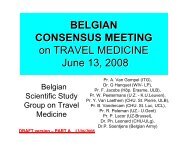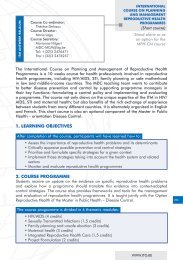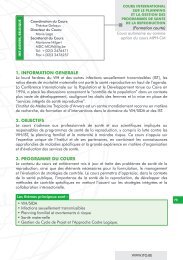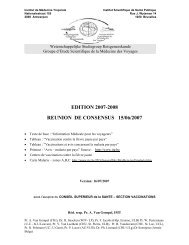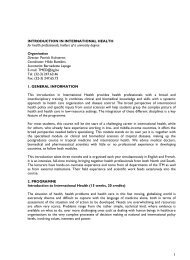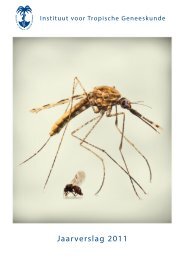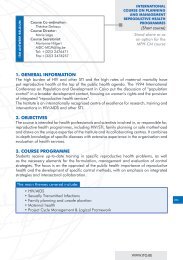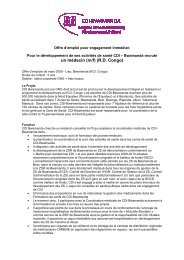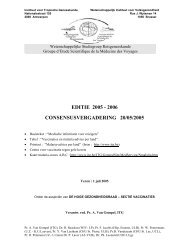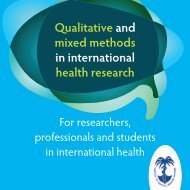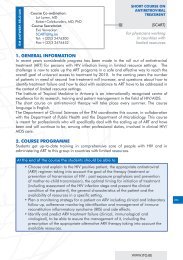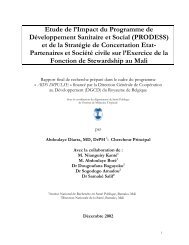Department of - Instituut voor Tropische Geneeskunde
Department of - Instituut voor Tropische Geneeskunde
Department of - Instituut voor Tropische Geneeskunde
Create successful ePaper yourself
Turn your PDF publications into a flip-book with our unique Google optimized e-Paper software.
Human T Lymphotropic Virus type 1<br />
(HTLV-1) in Peru<br />
HTLV-1 is a viral infection that is transmitted by<br />
prolonged breast feeding, transfusion <strong>of</strong> infected<br />
blood or sexual contact. Although most infections<br />
are asymptomatic, a minority <strong>of</strong> the infected subjects<br />
develop serious complications, including a debilitating<br />
neurological syndrome (tropical spastic paraparesis) or<br />
aggressive leukemias or lymphomas. Some patients are<br />
also sensitive to infectious complications, such as scabies,<br />
strongyloidiasis and onychomycosis. HTLV-1 infection is<br />
prevalent in West Africa, Japan, the Caribbean and the<br />
northern Andes region.<br />
Over the last two decades, Eduardo Gotuzzo, director <strong>of</strong><br />
the Institute <strong>of</strong> Tropical Medicine <strong>of</strong> Lima, has established<br />
a clinical and epidemiological cohort <strong>of</strong> 1,500 HTLV-1<br />
subjects, and their family members. This is one <strong>of</strong> the<br />
largest cohorts in the world.<br />
Tine Verdonck works on HTLV and other infectious<br />
diseases with Pr<strong>of</strong>. Eduardo Gotuzzo at the Institute<br />
<strong>of</strong> Tropical Medicine Caeyetano Heredia in Lima, Peru.<br />
She is also a key player in the collaborative capacity<br />
strenghtening programme.<br />
Highlight<br />
The ITM’s Unit <strong>of</strong> Virology collaborates in studies<br />
aiming to understand why only some <strong>of</strong> the infected<br />
subjects develop the disease and why the disease<br />
expression is clustered in three different syndromes,<br />
i.e. an inflammatory neurological one, an infectious<br />
one or a neoplastic one. The project is part <strong>of</strong> the<br />
ITM DGDC collaborative programme between the<br />
Antwerp and Lima institutes and is co-funded by the<br />
Flemish Interuniversity Council (VLIR). Other partners<br />
are the Medical Genetic <strong>Department</strong> <strong>of</strong> the University<br />
<strong>of</strong> Antwerp (Pr<strong>of</strong>. Van Camp and Dr. Van Laer) and the<br />
Catholic University <strong>of</strong> Leuven (Pr<strong>of</strong>. Van Damme). In<br />
Peru, Dr. Tine Verdonck, Dr. Daniel Clarck, Dr. Ivan Best<br />
and Dr. Michael Talledo are the main investigators<br />
working with Pr<strong>of</strong>. Gotuzzo. Several clinical trainees and<br />
master students in molecular biology are also involved<br />
trained in the project. Over a period <strong>of</strong> 4 years, we will<br />
collect clinical, epidemiological and biological data on<br />
800 HTLV-1 infected subjects. By the end <strong>of</strong> 2007, we<br />
had reached our mid-term target <strong>of</strong> 400 subjects. Tine<br />
Verdonck analysed the clinical and epidemiological<br />
features and convincingly demonstrated an increased<br />
risk for severe tuberculosis in HTLV-1 infected subjects.<br />
Together with the other researchers she published a<br />
prestigious review in the “Lancet Infectious Diseases” and<br />
papers in several other international journals. She will<br />
defend her PhD thesis in 2008 at the Antwerp University.<br />
Ivan Best analysed the T cell function in the patients and<br />
observed signs <strong>of</strong> spontaneous activation and increased<br />
activity <strong>of</strong> regulatory T cells in patients with neurological<br />
complications. He successfully defended his PhD thesis<br />
at the Caeyetano Heredia University in Lima. Ms. Vanessa<br />
Adaoui, together with Dr. Clarck, succesfuly developed<br />
an in-house assay test to measure the proviral load.<br />
Michael Talledo observed a genetic association between<br />
“Andean origin” and risk for neurological complications.<br />
RESEARCH | 39




